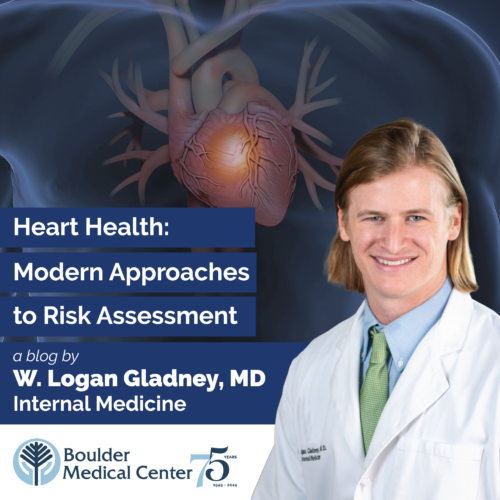Understanding Your Heart Health: Modern Approaches to Cardiovascular Risk Assessment

As a preventative medicine specialist and primary care physician, Dr. Gladney prioritizes cardiovascular risk assessment as a crucial part of patient health. Learn more and schedule an appointment.
by Logan Gladney, MD
Internal Medicine — Boulder Medical Center
The leading cause of death worldwide continues to be cardiovascular disease. Despite this, identifying those at the highest risk for events like heart attacks or strokes remains challenging. When these major events occur, they often happen suddenly, leading to emergency interventions. In such scenarios, expensive and invasive tests can reveal significant cardiovascular issues, such as coronary artery blockages, famously known as “widow makers.” While emergency treatments save lives, primary care physicians and patients prefer a preventative approach to avoid such crises.
Traditionally, assessing cardiovascular disease risk involves evaluating age, sex, race, and modifiable factors like blood pressure, smoking status, diabetes, and cholesterol levels. This data helps calculate a 10-year risk for cardiovascular events based on large studies tracking patients with these risk factors over time.
However, this approach overlooks several key risk factors, including a family history of heart disease and conditions like inflammatory arthritis, inflammatory bowel disease, obesity, or pre-diabetes. This raises concerns about whether current practices adequately assess cardiovascular risk in individuals who haven’t yet experienced major events.
How Imaging Technology Enhances Cardiovascular Risk Assessment
Two imaging technologies, CIMT (Carotid Intima-Media Thickness) and Calcium Score (Heart Score), are validated for detecting cardiovascular disease in patients without major events.
CIMT (Carotid Intima-Media Thickness)
CIMT uses ultrasound to measure the thickness of the carotid arteries in the neck, identifying atherosclerotic plaque. Increased carotid artery thickness indicates plaque buildup elsewhere in the body, like the heart and brain, which can lead to heart attacks and strokes. This test also calculates your “vascular age.” If your vascular age exceeds your actual age by five years or more, you are likely at a higher risk for cardiovascular disease.
Advantages of CIMT:
-
- Non-invasive imaging technology
- No radiation exposure
- Relatively low cost (copays range from $0-300)
- It can be repeated over time to monitor disease progression or improvement
Calcium Score (Heart Score)
The Calcium Score is a CT scan that uses X-rays to detect plaque buildup in the heart vessels. Cholesterol deposits along vessel walls eventually harden into calcified plaque. This test quantifies the amount of plaque and categorizes the risk as low (score of zero), moderate, or high.
Advantages of Calcium Score Testing:
-
- Accurate diagnosis of coronary artery disease
- It can be repeated to track disease progression or stabilization
Disadvantages:
-
- Uses a small dose of radiation
- Higher cost compared to ultrasound (copays of $100-400)
Next Steps After High-Risk Cardiovascular Testing Findings
If a high vascular age or significant plaque is detected through CIMT or Calcium Score, further investigation can identify underlying causes. Advanced lipid testing may be pursued, including cholesterol particle size analysis (NMR lipid analysis), lipoprotein levels, inflammatory markers, and genetic testing. Based on these findings, specialized diets and pharmaceutical agents, such as statins, can be considered.
Resources: Cardiovascular Risk Assessment
- Learn more about Dr. Gladney
- Schedule a comprehensive cardiovascular risk evaluation with Dr. Gladney:
- Schedule Online via Zocdoc
- Call to schedule an appointment at (303) 440-3082
- Calculate your 10-year stroke or heart attack risk
- Further reading: Beat the Heart Attack Gene: The Revolutionary Plan to Prevent Heart Disease, Stroke, and Diabetes by Bradley Bale and Amy Donnen

